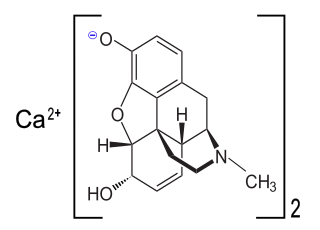Related Research Articles

Heroin, also known as diacetylmorphine and diamorphine among other names, is a morphinan opioid substance synthesized from the dried latex of the Papaver somniferum plant and is mainly used as a recreational drug for its euphoric effects. Medical-grade diamorphine is used as a pure hydrochloride salt. Various white and brown powders sold illegally around the world as heroin are routinely diluted with cutting agents. Black tar heroin is a variable admixture of morphine derivatives—predominantly 6-MAM (6-monoacetylmorphine), which is the result of crude acetylation during clandestine production of street heroin. Heroin is used medically in several countries to relieve pain, such as during childbirth or a heart attack, as well as in opioid replacement therapy.

Morphine is a strong opiate that is found naturally in opium, a dark brown resin produced by drying the latex of opium poppies. It is mainly used as an analgesic. There are numerous methods used to administer morphine: oral; sublingual; via inhalation; injection into a muscle, injection under the skin, or injection into the spinal cord area; transdermal; or via rectal suppository. It acts directly on the central nervous system (CNS) to induce analgesia and alter perception and emotional response to pain. Physical and psychological dependence and tolerance may develop with repeated administration. It can be taken for both acute pain and chronic pain and is frequently used for pain from myocardial infarction, kidney stones, and during labor. Its maximum effect is reached after about 20 minutes when administered intravenously and 60 minutes when administered by mouth, while the duration of its effect is 3–7 hours. Long-acting formulations of morphine are available as MS-Contin, Kadian, and other brand names as well as generically.

Opium is dried latex obtained from the seed capsules of the opium poppy Papaver somniferum. Approximately 12 percent of opium is made up of the analgesic alkaloid morphine, which is processed chemically to produce heroin and other synthetic opioids for medicinal use and for the illegal drug trade. The latex also contains the closely related opiates codeine and thebaine, and non-analgesic alkaloids such as papaverine and noscapine. The traditional, labor-intensive method of obtaining the latex is to scratch ("score") the immature seed pods (fruits) by hand; the latex leaks out and dries to a sticky yellowish residue that is later scraped off and dehydrated. The word meconium historically referred to related, weaker preparations made from other parts of the opium poppy or different species of poppies.

Thebaine (paramorphine), also known as codeine methyl enol ether, is an opiate alkaloid, its name coming from the Greek Θῆβαι, Thēbai (Thebes), an ancient city in Upper Egypt. A minor constituent of opium, thebaine is chemically similar to both morphine and codeine, but has stimulatory rather than depressant effects. At high doses, it causes convulsions similar to strychnine poisoning. The synthetic enantiomer (+)-thebaine does show analgesic effects apparently mediated through opioid receptors, unlike the inactive natural enantiomer (−)-thebaine. While thebaine is not used therapeutically, it is the main alkaloid extracted from Papaver bracteatum and can be converted industrially into a variety of compounds, including hydrocodone, hydromorphone, oxycodone, oxymorphone, nalbuphine, naloxone, naltrexone, buprenorphine, butorphanol and etorphine.

Glutethimide is a hypnotic sedative that was introduced by Ciba in 1954 as a safe alternative to barbiturates to treat insomnia. Before long, however, it had become clear that glutethimide was just as likely to cause addiction and caused similar withdrawal symptoms. Doriden was the brand-name version. Current production levels in the United States point to its use only in small-scale research. Manufacturing of the drug was discontinued in the US in 1993 and discontinued in several eastern European countries in 2006.

Papaverine is an opium alkaloid antispasmodic drug, used primarily in the treatment of visceral spasms and vasospasms, occasionally in the treatment of erectile dysfunction and acute mesenteric ischemia. While it is found in the opium poppy, papaverine differs in both structure and pharmacological action from the analgesic morphine and its derivatives.

Dihydromorphine is a semi-synthetic opioid structurally related to and derived from morphine. The 7,8-double bond in morphine is reduced to a single bond to get dihydromorphine. Dihydromorphine is a moderately strong analgesic and is used clinically in the treatment of pain and also is an active metabolite of the analgesic opioid drug dihydrocodeine. Dihydromorphine occurs in trace quantities in assays of opium on occasion, as does dihydrocodeine, dihydrothebaine, tetrahydrothebaine, etc. The process for manufacturing dihydromorphine from morphine for pharmaceutical use was developed in Germany in the late 19th century, with the synthesis being published in 1900 and the drug introduced clinically as Paramorfan shortly thereafter. A high-yield synthesis from tetrahydrothebaine was later developed.

Levomethorphan (LVM) (INN, BAN) is an opioid analgesic of the morphinan family that has never been marketed. It is the L-stereoisomer of racemethorphan (methorphan). The effects of the two isomers of racemethorphan are quite different, with dextromethorphan (DXM) being an antitussive at low doses and a dissociative hallucinogen at much higher doses. Levomethorphan is about five times stronger than morphine.

Nicomorphine is the 3,6-dinicotinate ester of morphine. It is a strong opioid agonist analgesic two to three times as potent as morphine with a side effect profile similar to that of dihydromorphine, morphine, and diamorphine.

Nicocodeine is an opioid analgesic and cough suppressant, an ester of codeine closely related to dihydrocodeine and the codeine analogue of nicomorphine. It is not commonly used in most countries, but has activity similar to other opiates. Nicocodeine and nicomorphine were synthesized in 1904, and introduced in 1957 by Lannacher Heilmittel of Austria. Nicocodeine is metabolised in the liver by demethylation to produce nicomorphine, also known as 6-nicotinoylmorphine, and subsequently further metabolised to morphine. Side effects are similar to those of other opiates and include itching, nausea and respiratory depression. Related opioid analogues such as nicomorphine and nicodicodeine were first synthesized. The definitive synthesis, which involves treating anhydrous codeine base with nicotinic anhydride at 130 °C, was published by Pongratz and Zirm in Monatshefte für Chemie in 1957, simultaneously with the two analogues in an article about amides and esters of various organic acids.

Dipropanoylmorphine is an opiate derivative, the 3,6-dipropanoyl ester of morphine. It was developed in 1972 as an analgesic. It is rarely used in some countries for the relief of severe pain such as that caused by terminal cancer, as an alternative to diamorphine (heroin) and morphine. The drug was first synthesised circa or about 1875 in Great Britain along with many other esters of morphine, all of which were shelved at the time, some of which were later developed such as heroin (1898), acetylpropionylmorphine (1923), dibenzoylmorphine, and so on. The name of this drug is also given as 3,6-dipropanoylmorphine and its 6-mono-acetylated homologue is also a longer-acting heroin-like drug, as are 3,6-diformylmorphine and 6-formylmorphine.

Codeine is an opiate and prodrug of morphine mainly used to treat pain, coughing, and diarrhea. It is also commonly used as a recreational drug. It is found naturally in the sap of the opium poppy, Papaver somniferum. It is typically used to treat mild to moderate degrees of pain. Greater benefit may occur when combined with paracetamol (acetaminophen) or a nonsteroidal anti-inflammatory drug (NSAID) such as aspirin or ibuprofen. Evidence does not support its use for acute cough suppression in children or adults. In Europe, it is not recommended as a cough medicine in those under 12 years of age. It is generally taken by mouth. It typically starts working after half an hour, with maximum effect at two hours. Its effects last for about four to six hours. Codeine exhibits abuse potential similar to other opioid medications, including a risk of habituation and overdose.

Benzylmorphine (Peronine) is a semi-synthetic opioid narcotic introduced to the international market in 1896 and that of the United States very shortly thereafter. It is much like codeine, containing a benzyl group attached to the morphine molecule just as the methyl group creates codeine and the ethyl group creates ethylmorphine or dionine. It is about 90% as strong as codeine by weight.

Heterocodeine (6-methoxymorphine) is an opiate derivative, the 6-methyl ether of morphine, and a structural isomer of codeine; it is called "hetero-" because it is the reverse isomer of codeine. Heterocodeine was first synthesised in 1932 and first patented in 1935. It can be made from morphine by selective methylation. Codeine is the natural mono-methyl ether, but must be metabolized for activity. In contrast the semi-synthetic mono-methyl ether, heterocodeine is a direct agonist. The 6,7,8,14 tetradehydro 3,6 methyl di-ether of morphine is thebaine.

Desomorphine is a semi-synthetic opioid commercialized by Roche, with powerful, fast-acting effects, such as sedation and analgesia. It was first discovered and patented by a German team working for Knoll in 1920 but was not generally recognized. It was later synthesized in 1932 by Lyndon Frederick Small. Small also successfully patented it in 1934 in the United States. Desomorphine was used in Switzerland under the brand name Permonid and was described as having a fast onset and a short duration of action, with relatively little nausea compared to equivalent doses of morphine. Dose for dose it is eight to ten times more potent than morphine.

Calcium morphenate is a calcium salt of morphine which is produced by using calcium bases to raise the pH of an aqueous solution of opium alkaloids to around 9.0. This was a method used in pharmaceutical manufacturing to separate morphine from other alkaloids and inert materials from the opium solution. Variations on this route are still used in Afghanistan. When poppy straw concentrate or opium latex is dissolved in hot water and the calcium base is added, calcium morphenate is formed. Treatment with a weak acid such as ammonium chloride then causes morphine freebase to precipitate, leaving codeine and other alkaloids of the plant in solution.

An opiate, is an alkaloid substance derived from opium It has a different meaning from the similar term opioid, used to designate all substances, both natural and synthetic, that bind to opioid receptors in the brain. Opiates are alkaloid compounds naturally found in the opium poppy plant Papaver somniferum. The psychoactive compounds found in the opium plant include morphine, codeine, and thebaine. Opiates have long been used for a variety of medical conditions with evidence of opiate trade and use for pain relief as early as the eighth century AD. Most opiates are considered drugs with moderate to high abuse potential and are listed on various "Substance-Control Schedules" under the Uniform Controlled Substances Act of the United States of America. Some, such as thebaine don't share the same effects and are not classified as controlled substances.

Acetylpropionylmorphine is an opiate analog that is an ester of morphine. It was developed in the early 1900s after first being synthesized in Great Britain in 1875 but shelved along with heroin and various other esters of morphine. Acetylpropionylmorphone was never used medically, instead being widely sold as one of the first "designer drugs" for around five years following the introduction of the first international restrictions on the sale of heroin in 1925. It is described as being virtually identical to heroin and morphine in its effects, and consequently was itself banned internationally in 1930 by the Health Committee of the League of Nations, in order to prevent its sale as an unscheduled alternative to heroin.

6-Monoacetylcodeine (6-MAC) is an acetate ester of codeine in which the hydroxyl group on the 6 position has been acetylated. It is occasionally present as an impurity in street heroin and is typically created when attempting to create heroin from a solution of morphine in which some of the codeine from the original opium solution still remains. It is formed either through the addition of acetic anhydride, which can only acetylate the 6 position on the codeine or as a result of the addition of acetic acid with a catalyst in an attempt to create 6-monoacetylmorphine, the equivalent ester of morphine which is slightly more potent than heroin itself. 6-monoacetylcodeine is eventually metabolised into codeine and then into morphine. Since only illegally produced heroin is likely to contain 6-MAC, testing for the presence of it in the urine can be used as a fairly reliable method of detecting the use of illicit heroin, as opposed to prescription painkillers. 6-MAC is the precursor for 14-hydroxycodeinenone which was the original precursor to oxycodone. The 7-8 double-bond was reduced using the hyposulfite ion to reduce the 6-7 double-bond. While the acute toxicity of 6-monoacetylcodeine has not been studied in man, animal studies have shown that in animal models its convulsant effects have been proved and when mixed with mono- or di- acetyl morphine, lowers the convulsant threshold of the mixture still further.

MacFarlan Smith is a pharmaceutical manufacturing company based in Edinburgh, Scotland, founded in 1815. After its sale from Johnson Matthey in June 2022 to Altaris Capital Partners, Macfarlan Smith rebranded as Veranova. Veranova is a CDMO specialising in the development and manufacturing of specialist and complex active pharmaceutical ingredients, or APIs. It has facilities across Europe, North America and Asia.
References
- ↑ New Zealand Institute of Chemistry. Biotechnology and Pharmaceuticals Documents. Opiate Chemistry and Metabolism Page accessed April 3, 2016
- ↑ Bedford KR et al. The illicit preparation of morphine and heroin from pharmaceutical products containing codeine: 'homebake' laboratories in New Zealand. Forensic Sci Int. 1987 Jul;34(3):197-204. PMID 3666623